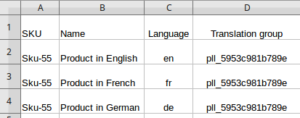Probably, the most important feature introduced by WooCommerce 3.1 is the possibility to export and import products with a CSV file. During the past weeks, we worked hard to make Polylang for WooCommerce compatible with this feature. How does it work?
When you will export your products with the new export tool, you will get one row per product and per language. Polylang for WooCommerce will automatically add two columns, one containing the language code, the other containing a unique id to identify translations groups. All the rows describing the translations of a same product will share the same unique id.

To import products, you will also need to create one row per product and per language. And you will need to setup these same 2 columns, “Language” and “Translation group”, in your CSV file. Once correctly mapped, Polylang for WooCommerce will use these 2 columns to assign the languages and setup the links between your product translations in your WooCommerce shop. Read our documentation to know more.
Polylang for WooCommerce 0.8 fixes also a few issues introduced by the release of WooCommerce 3.1, as well as several other pre-existing bugs.
Picture illustrating the article by Michael Siebert and licensed under CC0 Public Domain.
 Polylang
Polylang